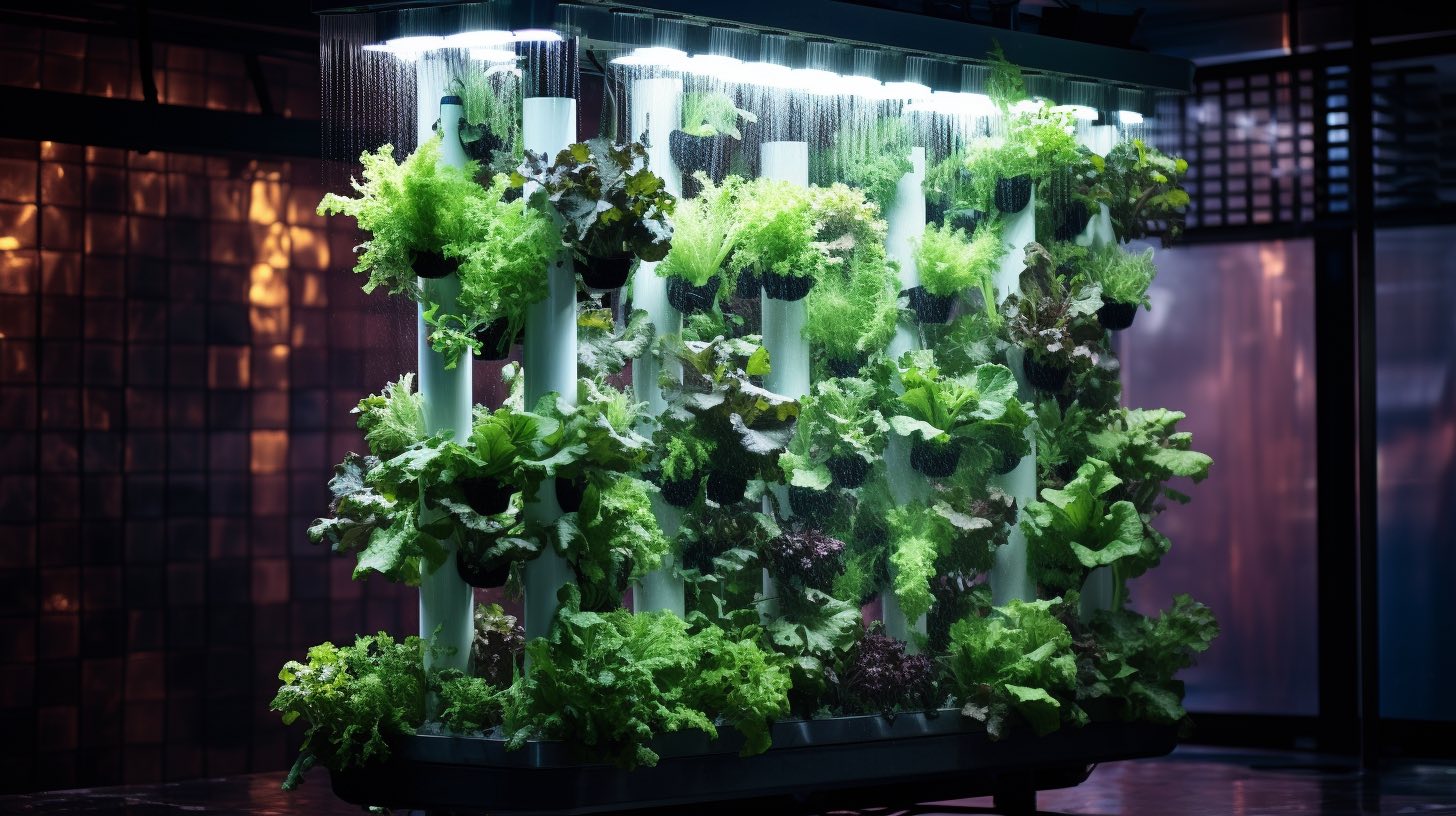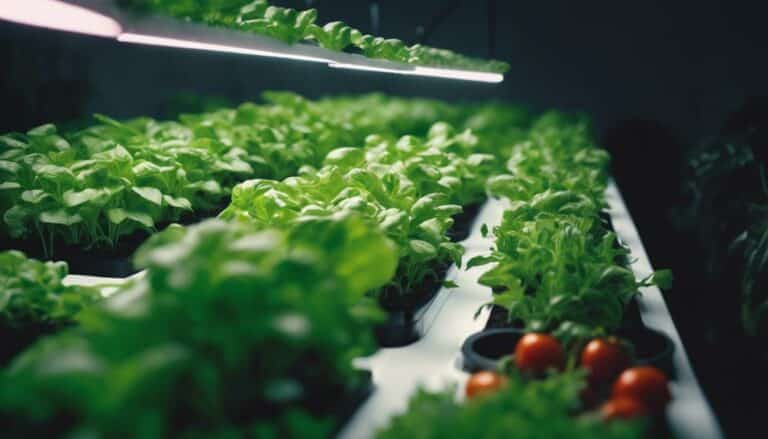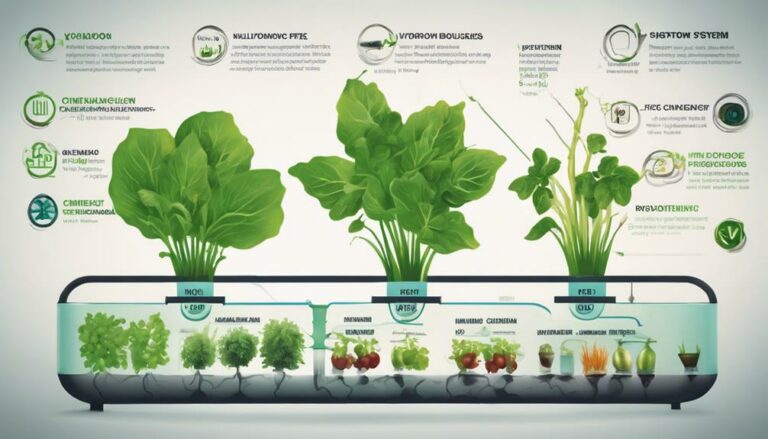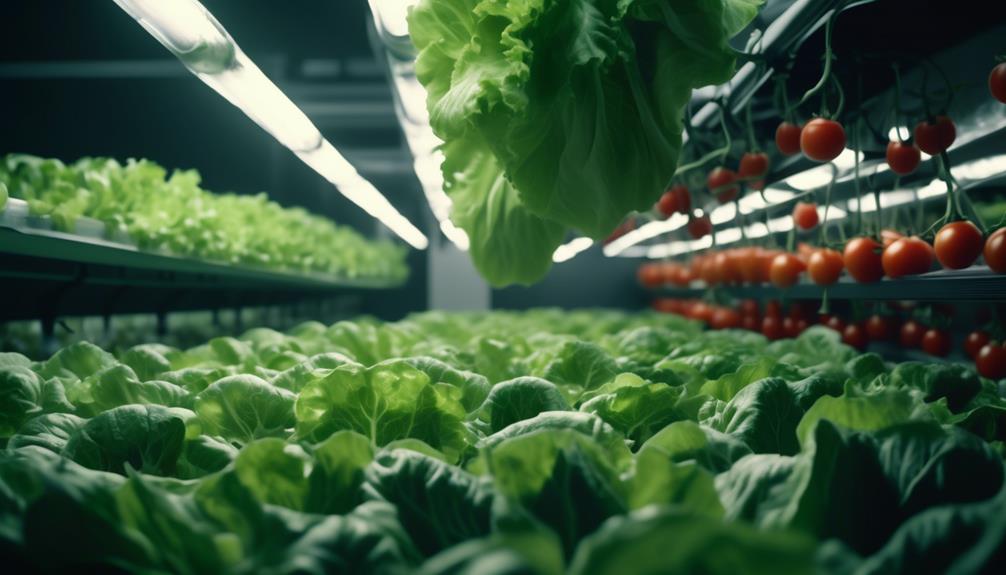Aeroponics systems are revolutionizing plant growth by harnessing the power of technology and research.
This article delves into the technical aspects of how aeroponics systems work to support optimal plant growth.
Table of Contents
From the role of nutrient solutions to the importance of root oxygenation, we explore the scientific principles behind this innovative method.
Discover the benefits of aeroponics for plant health and gain insights into setting up and maintaining an efficient aeroponics system.
Key Takeaways
- Aeroponics systems use misting to deliver nutrients and water to plant roots suspended in air.
- Increased oxygen availability in aeroponics promotes faster and healthier plant growth.
- Nutrient solution composition, including macronutrients and micronutrients, affects nutrient absorption by plants.
- Adequate oxygen supply to the roots ensures healthy root development and nutrient uptake.
The Basics of Aeroponics Systems
Aeroponics systems rely on a misting method to deliver nutrients and water directly to the plant roots suspended in air. This innovative system offers several benefits over traditional hydroponics methods.
One significant advantage is the increased oxygen availability to the roots, which promotes faster and healthier plant growth. Unlike hydroponics, where the roots are submerged in water, aeroponics allows for better aeration, preventing issues such as root rot and disease.
Another benefit of aeroponics is its water efficiency. Since the roots are misted with nutrient solution, there is minimal water wastage compared to hydroponics, where water is constantly circulated.
Additionally, aeroponics systems allow for precise control over nutrient delivery, ensuring plants receive the right amount of nutrients at the right time.
In comparison to hydroponics, aeroponics offers a more efficient and effective method for plant growth.
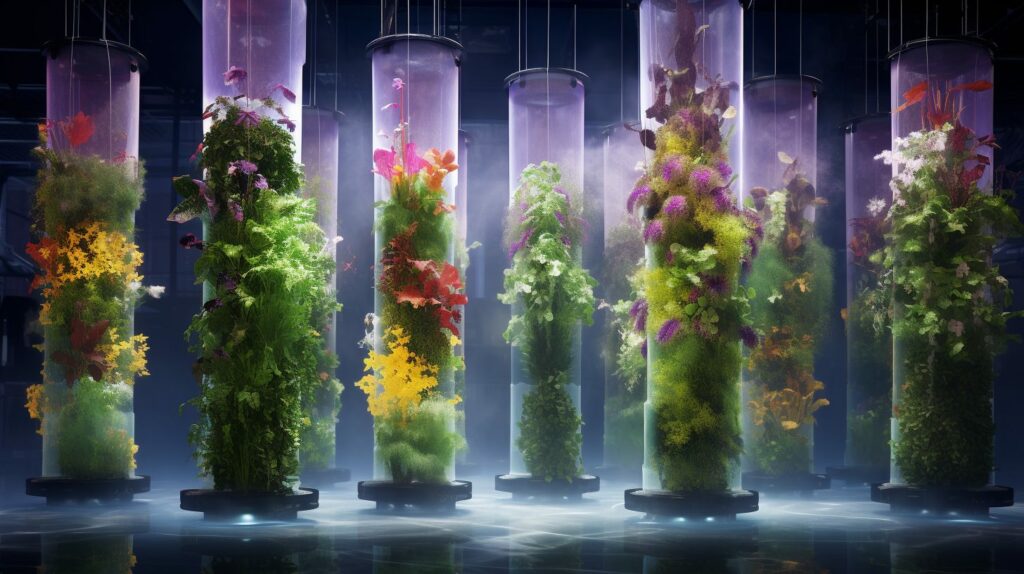
The Role of Nutrient Solution in Aeroponics
In the aeroponics method, the nutrient solution plays a crucial role in providing essential elements for optimal plant development. The nutrient solution composition directly affects the role of nutrient absorption by the plants.
Here are three key factors to consider in the nutrient solution composition:
- Macronutrients: The nutrient solution should contain an adequate amount of macronutrients such as nitrogen, phosphorus, and potassium. These elements are essential for plant growth and development.
- Micronutrients: In addition to macronutrients, the nutrient solution should also include micronutrients like iron, zinc, and manganese. These elements are required in smaller quantities but are equally important for various plant metabolic processes.
- pH Level: The pH level of the nutrient solution is crucial as it affects nutrient availability and absorption. A pH range of 5.5-6.5 is generally considered optimal for most plants.
The Importance of Root Oxygenation in Aeroponics
Root oxygenation is a critical factor in the success of aeroponic systems. Adequate oxygen supply to the roots ensures healthy root development and optimal nutrient uptake. Insufficient oxygen levels can lead to root rot, poor plant growth, and decreased overall system efficiency.
Therefore, understanding and maintaining proper root oxygenation is essential for maximizing the benefits of aeroponics in plant cultivation.
Oxygen for Healthy Roots
Oxygen levels in the root zone are crucial for maintaining healthy plant growth in aeroponic systems. In aeroponics, the roots are suspended in air and are misted with a nutrient-rich solution. Adequate oxygen supply to the roots is essential for proper root development and oxygen absorption.
Here are three key reasons why oxygen is vital for healthy roots in aeroponics:
- Enhanced nutrient uptake: Oxygen plays a crucial role in nutrient absorption by the roots. It assists in the breakdown of nutrients, making them more accessible to the plants.
- Prevention of root diseases: Sufficient oxygen levels in the root zone help prevent the growth of harmful pathogens and root rot, ensuring healthier plants.
- Stimulates root growth: Oxygen stimulates the production of root hormones, promoting root growth and enhancing the overall health of the plant.
Aeroponics and Root Oxygen
Adequate oxygen supply to the roots is crucial for maintaining the health and vitality of plants in aeroponic cultivation. In aeroponics, plants are grown with their roots suspended in air and misted with a nutrient-rich solution. This unique method allows for the efficient uptake of nutrients by the plants’ roots.
The root structure in aeroponics is highly developed, with numerous fine root hairs that maximize the surface area available for nutrient absorption. These root hairs are also responsible for the uptake of oxygen from the surrounding air. The oxygen is essential for various physiological processes, including respiration and nutrient uptake.
Without sufficient oxygen, the roots become stressed, leading to reduced nutrient absorption and overall plant health. Therefore, it is crucial to ensure a constant and adequate supply of oxygen to the roots in aeroponic systems to promote optimal plant growth and development.
The Science Behind Plant Growth in Aeroponics Systems
Aeroponics systems rely on the precise delivery of nutrient-rich mist to foster optimal plant growth. This innovative technique allows plants to grow in an air or mist environment, eliminating the need for soil.
The science behind plant growth in aeroponics systems is fascinating and involves several key factors:
Plant growth factors
- Light: Adequate light intensity and duration are crucial for photosynthesis and plant growth.
- Temperature: Maintaining the ideal temperature range promotes metabolic activity and enhances plant growth.
- Humidity: Proper humidity levels promote transpiration and nutrient absorption.
Plant nutrient uptake:
- Nutrient-rich mist: The mist contains essential nutrients that are absorbed directly by the plant’s roots.
- Oxygen: The roots are exposed to oxygen, ensuring efficient nutrient uptake and preventing root diseases.
- pH and EC levels: Monitoring and adjusting the pH and electrical conductivity (EC) of the mist solution ensures optimal nutrient absorption.
Understanding these plant growth factors and optimizing nutrient uptake in aeroponics systems allows for faster growth rates, increased yields, and healthier plants.
The Benefits of Aeroponics for Plant Health
Aeroponics, as a modern agricultural technique, offers several benefits for plant health, resulting in increased crop yield and improved environmental sustainability.
One of the key advantages of aeroponics is its ability to provide plants with a highly oxygenated and nutrient-rich environment. By suspending plant roots in a mist of nutrient solution, aeroponics ensures optimal absorption of nutrients and water, leading to healthier plants and higher yields.
Additionally, the controlled and sterile nature of aeroponic systems minimizes the risk of disease and pest infestations, further enhancing plant health.
Moreover, aeroponics significantly reduces water usage compared to traditional soil-based farming methods, contributing to environmental sustainability.
The efficient use of resources in aeroponics, combined with its ability to maximize crop yield, makes it an attractive and sustainable solution for meeting the growing demand for food production.
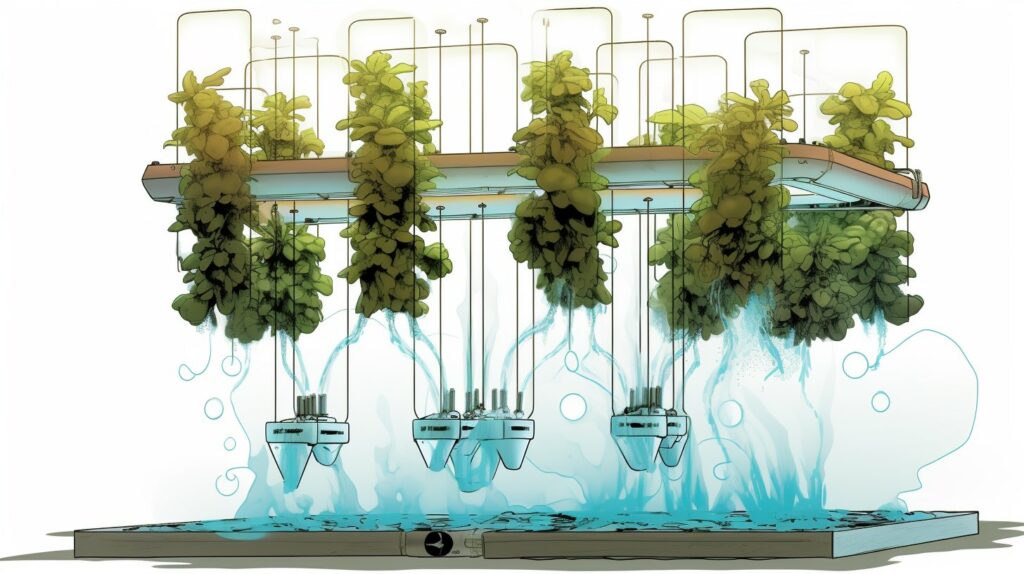
How to Set Up and Maintain an Aeroponics System
Setting up and maintaining an aeroponics system requires careful planning and attention to detail.
The installation process involves securing the necessary equipment, such as a reservoir, pump, spray nozzles, and a timer.
Once the system is set up, ongoing maintenance tasks include monitoring and adjusting the nutrient solution, ensuring proper airflow and humidity levels, and troubleshooting any issues that may arise.
System Installation Tips
During the installation process of an aeroponics system, it is important to ensure proper alignment and secure placement of the components to ensure optimal plant growth and system functionality. Here are some tips to consider:
Component Placement
- Mount the misting nozzles at a height that allows for even coverage of the plant roots.
- Position the nutrient reservoir below the growing chamber to facilitate gravity-driven nutrient delivery.
- Securely attach the misting lines to prevent leaks and ensure consistent nutrient delivery.
System Maintenance
- Regularly clean the misting nozzles to prevent clogging and ensure efficient nutrient delivery.
- Monitor and adjust the nutrient solution pH and nutrient levels to optimize plant growth.
- Inspect the system for any signs of damage or leaks and promptly repair or replace affected components.
Optimizing Nutrient Delivery:
- Use a high-quality nutrient solution specifically designed for aeroponics systems.
- Consider incorporating root-zone temperature control to enhance nutrient uptake.
- Implement a nutrient delivery schedule that provides a balance between nutrient availability and adequate oxygenation of the roots.
Nutrient Solution Management
Proper management of the nutrient solution is crucial for maintaining optimal nutrient levels and ensuring the health and vitality of the plants in an aeroponics system. The nutrient solution composition and delivery play a vital role in providing essential nutrients to the plants. The nutrient solution needs to be balanced and tailored to the specific requirements of the plants being grown. It should contain the necessary macro and micronutrients, as well as other additives such as pH adjusters and growth enhancers.
To effectively manage the nutrient solution, it is important to monitor and adjust its composition regularly. This can be done by measuring the pH and electrical conductivity (EC) of the solution. The pH should be maintained within a specific range, typically between 5.5 and 6.5, to ensure optimal nutrient uptake. The EC, which indicates the concentration of nutrients in the solution, should be adjusted based on the growth stage of the plants.
In addition to composition, the delivery of the nutrient solution is equally important. In an aeroponics system, the solution is typically delivered as a fine mist or aerosol to the plant roots. This allows for efficient nutrient absorption and oxygenation of the roots. The delivery system should be designed to evenly distribute the solution to all the plants in the system, ensuring that each plant receives an adequate amount of nutrients.
The following table summarizes some key considerations for nutrient solution management in an aeroponics system:
| Nutrient Solution Management |
|---|
| Composition |
| – Balanced macro and micronutrients |
| – pH adjusters |
| – Growth enhancers |
| Delivery |
| – Fine mist or aerosol delivery |
| – Even distribution to all plants |
| Monitoring and Adjusting |
| – Regular pH and EC monitoring |
| – Adjusting pH and EC based on plant requirements |
Proper management of the nutrient solution is essential for the success of an aeroponics system. By ensuring the right composition and delivery, growers can optimize plant growth and achieve healthier and more productive crops.
Troubleshooting Common Issues
In order to address common issues encountered in managing the nutrient solution, a thorough troubleshooting process must be implemented. When troubleshooting common issues in aeroponics systems, it is important to consider the following:
- pH imbalance:
- Test and adjust the pH of the nutrient solution regularly.
- Use pH buffers to maintain the desired pH range.
- Check for any potential sources of contamination that may affect the pH.
- Nutrient deficiency:
- Monitor the nutrient levels and adjust accordingly.
- Ensure that all essential nutrients are present in the solution.
- Check for any signs of nutrient deficiency in the plants, such as yellowing leaves or stunted growth.
- Clogged misters:
- Inspect and clean the misters regularly to prevent clogging.
- Use filtered water or a water treatment system to prevent mineral buildup.
- Adjust the pressure of the system to prevent excessive misting or clogging.
Frequently Asked Questions
What Are the Potential Disadvantages or Limitations of Using Aeroponics Systems for Plant Growth?
Potential drawbacks and limitations of using aeroponics systems for plant growth include high initial setup costs, technical complexity, and the need for continuous monitoring and maintenance. Additionally, the reliance on a nutrient mist can lead to potential plant stress and susceptibility to disease.
Can Aeroponics Systems Be Used for All Types of Plants, or Are There Specific Plants That Benefit the Most From This Cultivation Method?
Aeroponics systems offer benefits for various plant species, but certain plants show greater growth and yield improvement compared to traditional cultivation methods. Research indicates that leafy greens, herbs, and certain fruiting plants thrive exceptionally well in aeroponic environments.
How Does the Cost of Setting up and Maintaining an Aeroponics System Compare to Traditional Soil-Based Gardening or Hydroponics Systems?
The cost of setting up and maintaining an aeroponics system should be compared to traditional soil-based gardening and hydroponics systems. This evaluation should consider the initial investment, ongoing maintenance requirements, and potential long-term benefits of each method.
Are There Any Specific Safety Considerations or Precautions That Need to Be Taken When Using Aeroponics Systems?
Safety considerations and precautions are essential when using aeroponics systems. These may include ensuring proper ventilation, regular maintenance of equipment to prevent contamination, and monitoring nutrient levels to prevent overexposure or nutrient imbalances that could harm plants and users.
Can Aeroponics Systems Be Used in Outdoor Environments, or Are They Primarily Designed for Indoor or Controlled Environments?
Aeroponics systems can be used in outdoor environments, although they are primarily designed for indoor or controlled environments. The benefits of aeroponics systems for urban farming include increased crop yields, water efficiency, and the ability to grow in limited space.
Conclusion
In conclusion, aeroponics systems provide an innovative and efficient method for plant growth. By delivering nutrient solution directly to the roots while ensuring optimal oxygenation, these systems optimize plant health and growth.
The scientific principles behind aeroponics systems contribute to the numerous benefits they offer, including increased yields, faster growth rates, and reduced water and nutrient requirements.
With proper setup and maintenance, aeroponics systems have the potential to revolutionize agricultural practices and contribute to sustainable food production.

